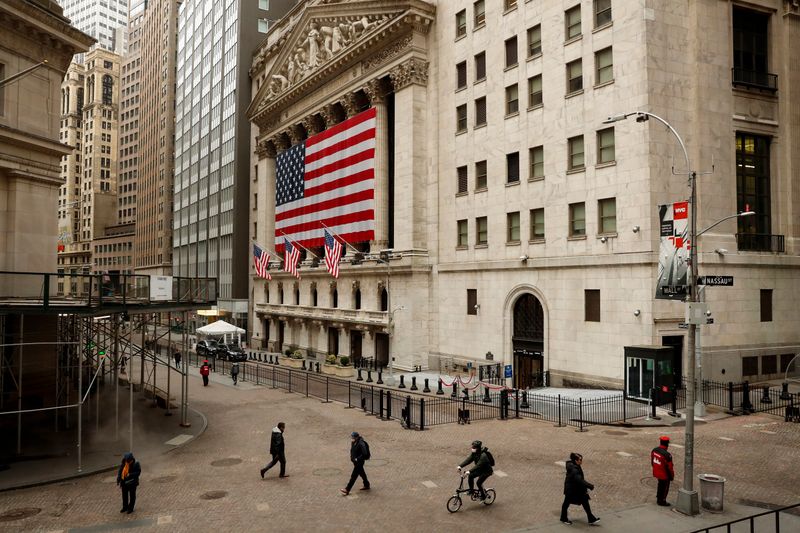By Saqib Iqbal Ahmed and April Joyner
NEW YORK (Reuters) - Investors are treating the U.S. equity market’s blistering rally with a dose of caution, socking away cash, staying on the sidelines or buying insurance against a reversal even as markets scream higher in the midst of the coronavirus pandemic.
Fund managers and corporations have deployed over $1.1 trillion into money markets while the S&P 500 mounted a nearly 30% bounce from its March lows. Assets in such funds grew to a record $4.73 trillion in April.
(GRAPHIC: Money fund assets hit a record high after a rapid rise this year - https://fingfx.thomsonreuters.com/gfx/mkt/rlgpdwnaovo/Money%20markets.jpg)
Gold and other popular haven assets have edged higher, while surveys show investors remain largely pessimistic. And Berkshire Hathaway (NYSE:BRKa) CEO Warren Buffet, famous for buying on the cheap in past crises, revealed over the weekend that the firm had sold its entire position in four U.S. airline companies and not made any new purchases during the selloff.
"There are a number of investors that think that maybe we have gone a little too far, a little too fast," said Mark Stoeckle, chief executive officer of Adams Funds.
Pessimism during rallies is not uncommon, and some argue that markets are more prone to reversals when euphoria predominates. Unprecedented stimulus from the Federal Reserve and U.S. government have been a key factor in boosting investor confidence and alleviating market stresses.
But many are worried that the lightning-quick bounce could easily reverse if markets are hit with bad news on any number of fronts, including the efforts of U.S. states and countries to gradually reopen their economies or a re-escalation of the U.S.-China trade war.
"Investors are pricing a reality that doesn't strike me as highly probable to unfold," said Hans Olsen, chief investment officer of Fiduciary Trust Company. "We are beginning to think we should be reducing risk at this juncture."
The rally's doubters include DoubleLine Capital's Jeffrey Gundlach, who said last week he had placed a bearish bet against the S&P 500 at 2863, and Scott Minerd, chief investment officer of Guggenheim Investments, who believes the stock benchmark could fall as low as 1,200.
“Many promising ... rallies fizzle as the initial euphoria clears and the grim realities of underlying fundamentals come to the fore,” analysts at Societe Generale (OTC:SCGLY) said in a report studying how stocks have behaved during bear markets over the past 150 years.
The typical bear market has been slower to rebound from the bottom, averaging an 11% gain in the first three months after stocks hit a trough, the bank’s research found.
Matt Forester, chief investment officer of BNY Mellon’s Lockwood Advisors, increased his firm's holdings in gold over the last several weeks, concerned that the market's recent gains have been concentrated in a cluster of big technology and communications companies.
The S&P's top 20 stocks accounted for 35% of its rally, analysts at Goldman Sachs (NYSE:GS) said last month. The price of gold
Meanwhile, investors and corporations poured $512 billion into money market funds, typically viewed as low-risk, low-return investments, since March 25, more than in all of 2019, according to data from Investment Company Institute and Crane Data.
"Institutions … continue to build cash at a feverish pace,” said Peter Crane, president of Crane Data, which tracks the money market industry. “No war chest is big enough for the coronavirus."
Robert Phipps, director at Per Stirling Capital Management, is maintaining a 9% cash allocation, versus a typical 3% to 5%.
“I still think there’s got to be a pullback at some point,” he said.
Plenty of investors believe markets have already seen their lows. Michael Wilson, equity strategist at Morgan Stanley (NYSE:MS), believes "seemingly unlimited central bank support" and fiscal stimulus will bolster equity performance.
Fed support and fiscal stimulus led analysts at JP Morgan to boost their weighting on U.S. stocks to "neutral" from "underweight" on Monday.
Yet bearishness among retail investors remains high. The American Association of Individual Investors (AAII) sentiment survey for the week ended April 29 showed a 44% bearish reading. On a 4-week moving average basis, that reading hit a high of 50% in early April, its most bearish since 2009.
(GRAPHIC: AAII Sentiment Survey: Bearish - https://fingfx.thomsonreuters.com/gfx/mkt/jbyprjkerpe/AAII.jpg)
At the other end of the spectrum, hedge funds have stayed underweight in equities despite the rally, an analysis by Deutsche Bank (DE:DBKGn) found.
And while volatility has subsided in recent weeks, some investors are betting that markets will remain turbulent in coming months.
Marc Odo, client portfolio manager at Swan Global Investments, has 15% of his portfolio invested in long-term put options to help hedge downside risk. He's concerned the market's gains don't reflect the U.S. economy's weakened state.
"If you were to look at either the economic numbers or the market numbers separately ... it would be fine," he said. "When you merge the two and justify one versus the other, I can't square that circle. Something has to give."
